Snapps courses are now available
You can build a lead generation website for small businesses in three steps.
- Write your unique value proposition (UVP). Don't forget your lead generation goals and content marketing plan.
- Choose your website-building method. Are you getting a website-building platform, using a CMS tool, or hiring a professional?
- Build your website and landing pages, and launch them.
In this article, you’ll find a thorough rundown of these three steps. You'll also read more about the best practices and the common mistakes to avoid. You'll find ten examples of the best lead generation websites in 2024 to help inspire your start.
How to Build a Lead Generation Website for Small Businesses in 3 Steps
Learning how to build a lead generation website for small businesses requires three steps. That’s if you’re using a website builder. The good news is that it’s not as difficult as it sounds. You don’t have to be a professional website designer to make one.
STEP #1: Define Your UVP, Lead Generation Goals, and Content Marketing Plan
Begin by defining your unique value proposition (UVP). Your UVP is your statement of assurance to your customers. You’re promising that your product or service can help solve their pain points.
Next, your lead generation goals. Follow this guide and write one goal based on each:
- How do you create a good online impression that will attract interest?
- How will your customer support help address pain points and help resolve them?
- How do you engage your target market and ask for feedback about your product or service?
- What are your steps for nurturing leads that will lead to earning revenue?
After writing your lead generation goals, create your content marketing plan. Include the following:
- Buyer persona - Create a representative of your target market. Be as detailed as possible in describing who your prospective customers are and their pain points.
- Keywords - An online tool like Google Keyword Planner will help you with keyword research. It can also help fine-tune your search intent.
- Personalized marketing messages - Identify the individual segments within your target market. Find out their unique needs. You can create a more user-focused marketing message that way.
- Content calendar and types of content - Organize when you’re publishing content. Create blog articles to share information. Produce videos to show your product or service. Create proposals or product pages with lead capture forms to convert leads. Publishing regularly improves your search ranking.
- Promotional channels - After publishing your website, start promoting it through social media. Facebook, LinkedIn, and Twitter help draw awareness and interest. Do guest posts or partnerships with brands that complement your business, too.
STEP #2: Choose Your Website-Building Tool or Platform
When choosing your website-building tool or platform, you need to consider the following:
1. Is using a website-building platform recommended for small business lead generation websites?
A website-building platform is recommended for building small business lead generation websites. It is the most affordable option and offers a quicker time to market. Learning how to use a website builder is easier, too. Some even guides for you to follow. Some platforms like Snapps.ai also provide SEO and lead generation tools, and domain hosting services.
2. Wouldn’t a CMS tool be ideal for creating lead generation websites?
A CMS tool like WordPress is ideal for creating lead generation websites. However, CMS has a steep learning curve. It isn’t as user-friendly as a website builder. It requires prior experience in coding and doesn’t offer domain hosting. Some CMS platforms (WordPress alternatives) are pricier than website builders.
3. Isn’t hiring a freelance professional or agency easier?
Hiring a freelance professional or agency is easier. You won’t have to do anything with building your website. But it is the most expensive and time-consuming option. Forbes.com states that the hiring expenses can run anywhere from $1,000 to $10,000. On top of that, you won’t have full control over your website. Need to post content or site updates? Everything goes through your designer.
A website builder like Snapps.ai would be perfect for your needs. It can help create a professional-looking lead generation website quickly and efficiently. And you’ll have full control over your website and content.
In a subreddit about the best platform for creating a business website, redditor LocalSEOhero states that website builders like Snapps.ai have a lot of slick features. He adds it does not take a lot of learning for clients to manage their websites themselves.

In an older subreddit, BlueCaribYou recommends Snapps.ai as a fast and cost-effective way to build niche (small business) websites.
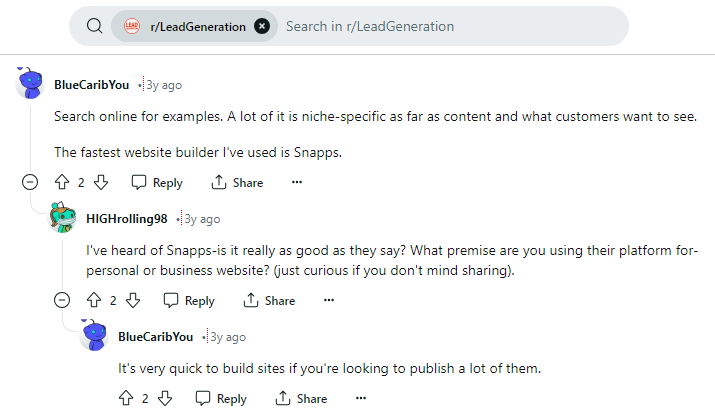
STEP #3: Build and Launch Your Lead Generation Website and Landing Pages
After choosing which website builder to use, it’s time to build your site and landing pages.
1. Choose your lead gen website template. With a website builder like Snapps.ai, you have an array of built-in design templates.
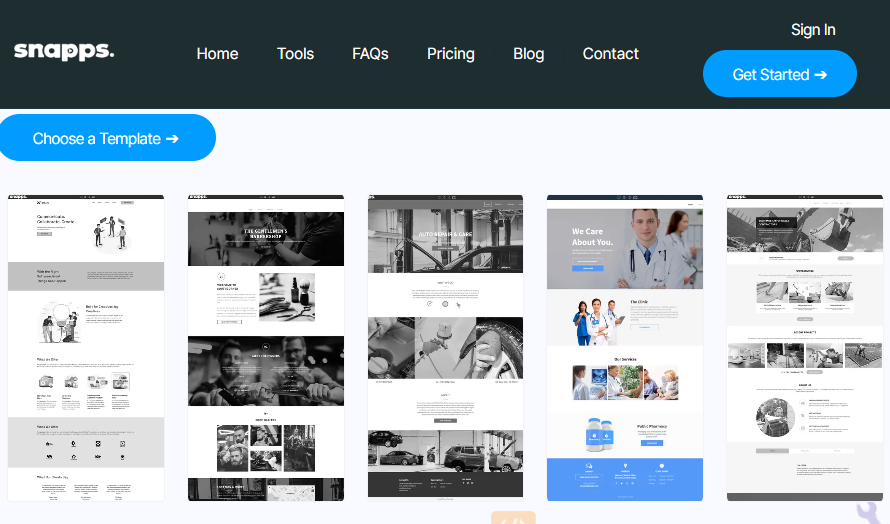
2. Customize your website template. Rule of thumb: Lead generation websites are straightforward. They show visitors the solutions to their pain points and the action they need to take. In addition, you’ll need the following tools to measure your site’s performance:
- Website analytics
- SEO analytics
- Conversion rate optimization (CRO)
3. Create your landing pages and lead capture forms using built-in apps. For your landing pages, please include:
- Concise and engaging content
- Highly visible placement of call-to-action (CTA) button/s
- Trust signals and social proofs
- Optional: a single high-resolution image or video that is your visual focal point
Once you’ve finished your website and landing pages, it’s time to publish your work. Most website builders offer domain hosting. For example, with Snapps.ai, you can sign in to
Snapps Domains
Best Practices: How to Build a Lead Generation Website for Small Businesses Using 11 Essential Features
A strong online presence helps your small business expand its reach and growth. Below are the 11 essential features to include in your lead generation website. They will help you achieve the three goals for creating a user-focused website:
- Creating user-focused content marketing and engagement
- Supporting your lead generation and nurture strategies
- Creating opportunities to improve your lead generation efforts
3 Features that Create User-Focused Content Marketing and Engagement
- Compelling and Well-Placed CTAs
- Mobile Optimization
- Well-designed Lead Capture Forms
Well-placed call-to-action (CTA) buttons help visitors take the action. Mobile optimization helps create a seamless user experience no matter the device. Your lead capture forms help with engagement.
4 Features that Support Your Lead Generation and Nurture Strategies
- Unique Value Proposition (UVP) and Content Marketing
- User-Friendly Website and Landing Page Design
- Website Analytics Tools
- Conversion Rate Optimization (CRO) Tool
Your UVP and content marketing help create user-focused content. In the same way, a user-focused website enhances engagement. It maximizes the effect of your targeted marketing campaigns.
To measure how effective your lead gen activities are, integrate analytics tools. These tools compile organic traffic and user behavior data. These data help with enhancing site design, speed, and performance. Conversion rate optimization (CRO) tools help improve your lead conversion rates.
4 Features that Improve Your Lead Generation Strategies
- Regular A/B Testing for Improving Lead Strategies
- Trust signals and social proofs
- Marketing automation tools
- Integrated webpage design templates (For targeted landing pages)
Once you’ve published your website, set up your A/B testing to improve your website and campaigns. Another way to improve your website is by adding trust signals and social proof. They help reassure visitors you’re there to help them. Once you’ve A/B tested your website and lead generation strategies, you’ll need new landing pages and lead nurturing. To optimize your lead nurturing and conversions, integrate marketing automation tools.
These 11 essential features help establish a strong online presence and drive growth for your small business.
Common Mistakes to Avoid When Learning How to Build a Lead Generation Website for Small Businesses
- Lack of clarity in your UVP.
- Underdeveloped strategies for resolving customer pain points.
- Undefined target market and segmentation that results in poor lead generation campaigns.
- Poor website design. This includes a nonintuitive user interface, slow site speed, and poor mobile responsiveness.
- Lack of marketing automation and communication tools resulting in poor lead nurturing.
- Lack of A/B testing resulting in a lack of basis for website improvements.
A mistake can cause missed marketing opportunities and lost leads. Avoid these mistakes to enhance your site’s searchability. You can also ensure a positive user experience.
10 Examples of the Best Lead Generation Websites for 2024
Below are 10 examples of the best lead generation websites for 2024. Not all of these are small business websites. But they are great examples of how well-placed lead generation elements help drive conversions:
Ippei Leads

Ippei Leads is a solid example of what your lead generation website should look like. It is direct-to-the-point in its messaging stating the name of the business, its UVP, and a call-to-action (CTA) button.
OptinMonster
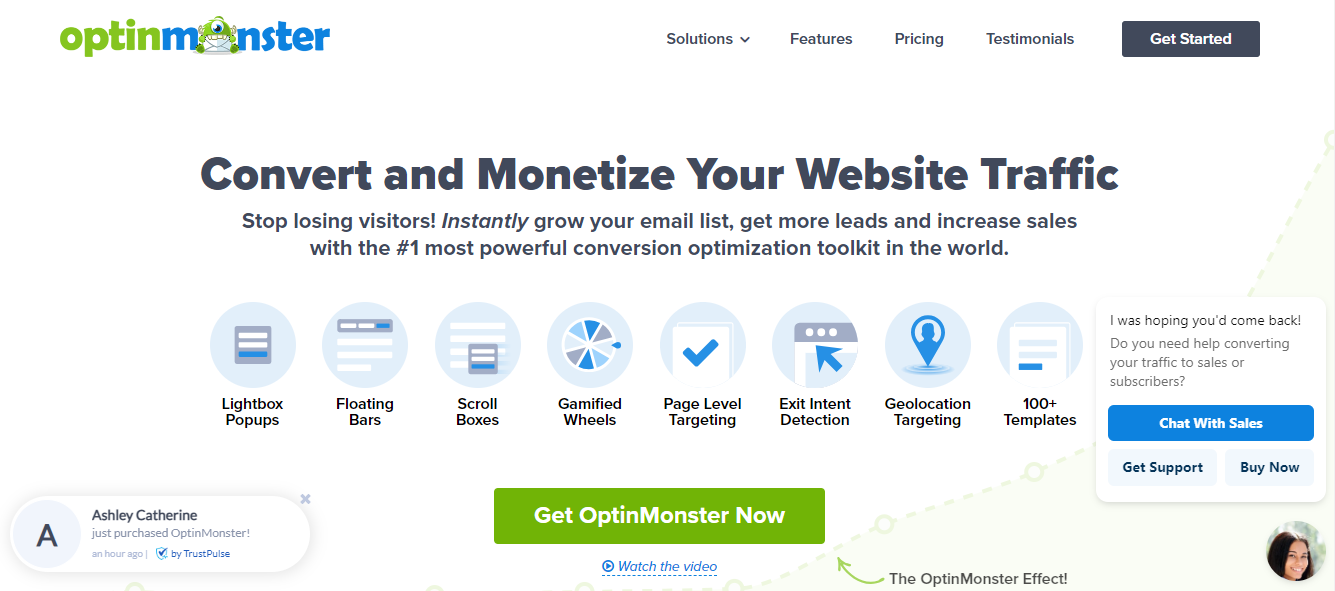
OptinMonster is a good example of using lead magnets. It uses a user-focused header. It includes trust signals and social proofs to gain visitor trust and confidence.
Basecamp
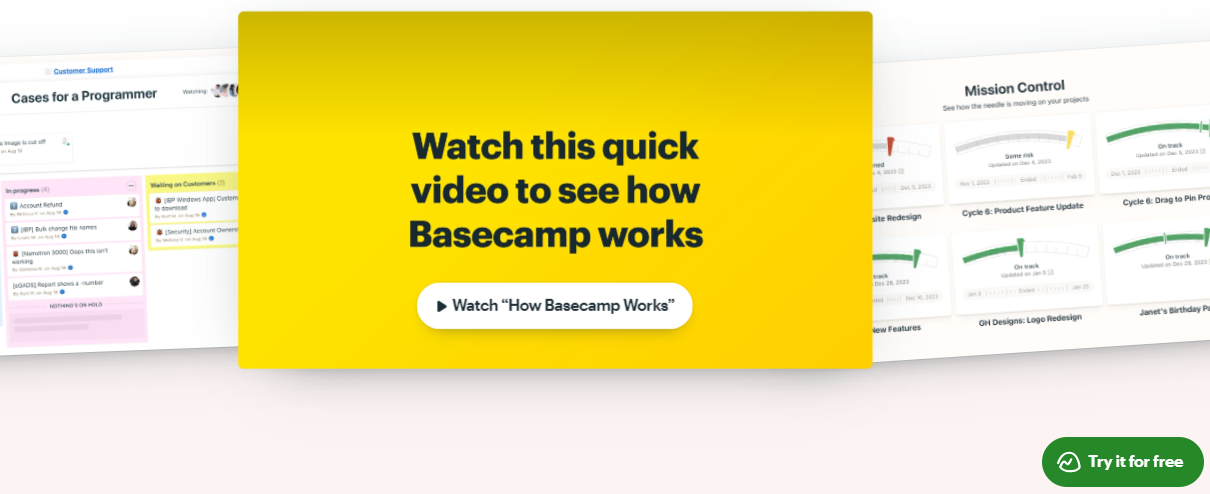
Straightforward and well-executed lead generation strategy. Basecamp addresses customer pain points right away. Then, it outlines possible solutions via a lead magnet (video). A green-colored CTA on the bottom-righthand corner is another lead magnet with an enticing offer.
Discord

Discord is not a small business. But it's a good example of how great content and CTAs attract visitors and encourage them to take action.
Modern Physical Therapy
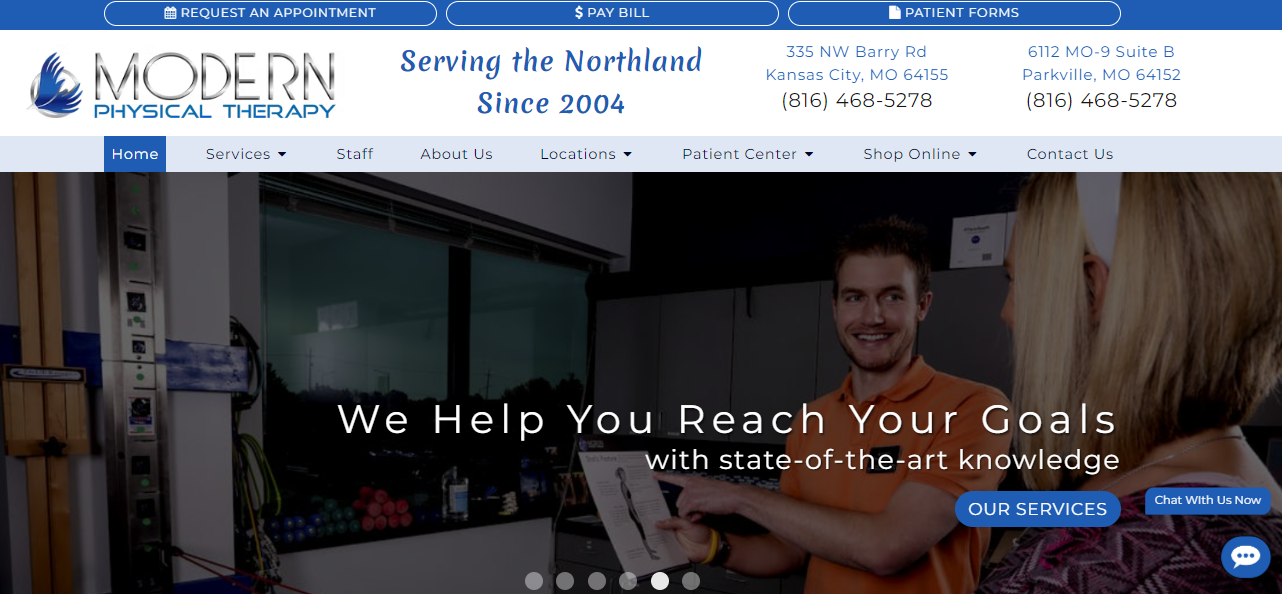
Like most small businesses, Modern Physical Therapy offers in-person services. It shows how a great top-fold design can attract interest and push visitors to action.
Rocket Mortgage
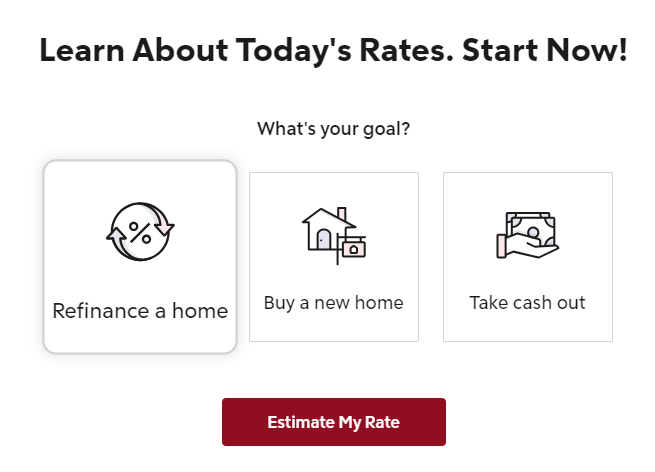
Rocket Mortgage immediately addresses customer pain points and provides solutions. Its visually distinct CTA tells site visitors what to do next.
NerdWallet

NerdWallet uses well-written content and user-focused CTAs (lead magnets) to engage leads and convert them.
Best Choice Products
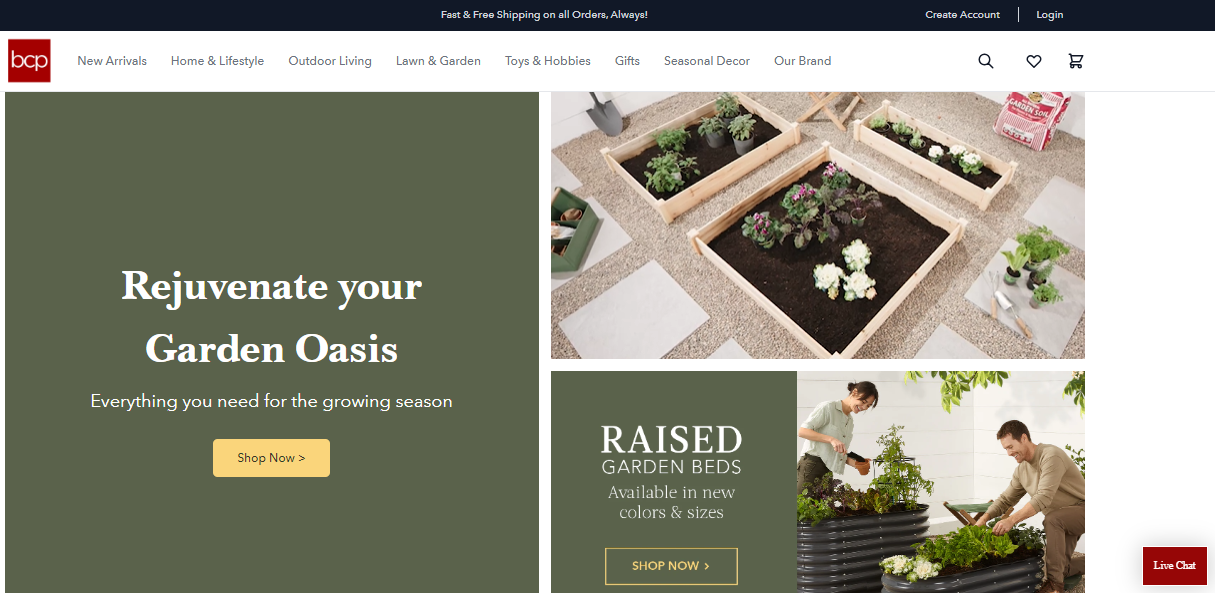
An online catalog, Best Choice Products provides clear CTAs. It uses product categories as lead magnets. Its page layout is neat, making navigation easy and direct.
True Classic
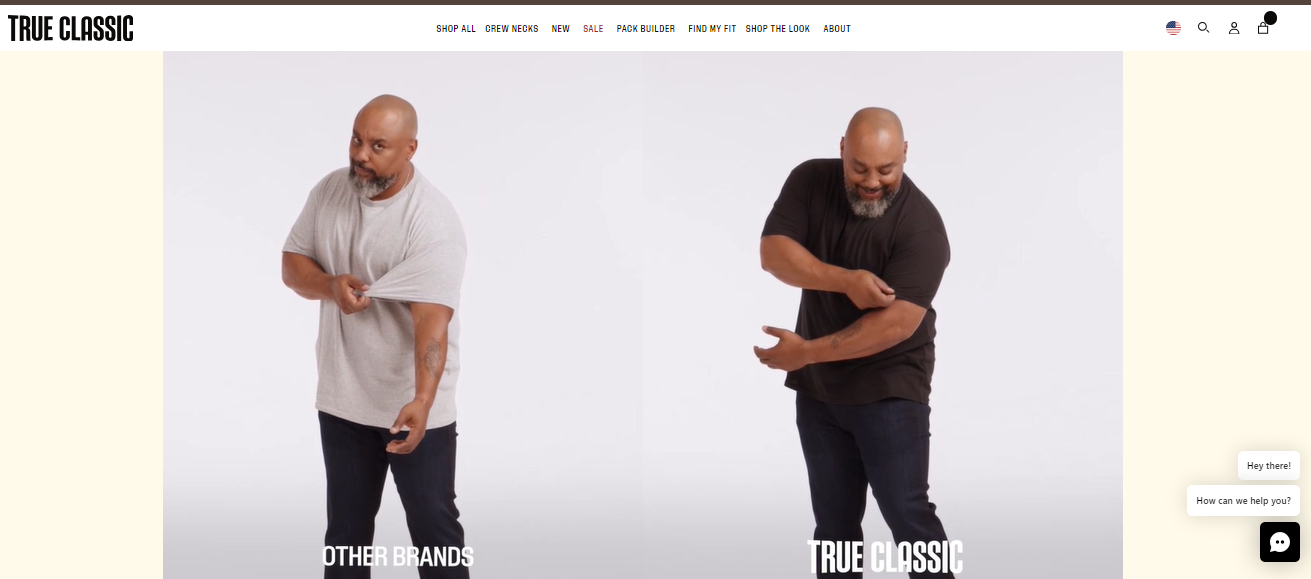
True Classic is a men’s clothing brand that uses a well-executed UVP. This UVP shows customer pain points and immediately presents the solution. It supports its key message with two short chat messages at the bottom-righthand corner (lead magnet). Subtle and user-focused.
Zumper
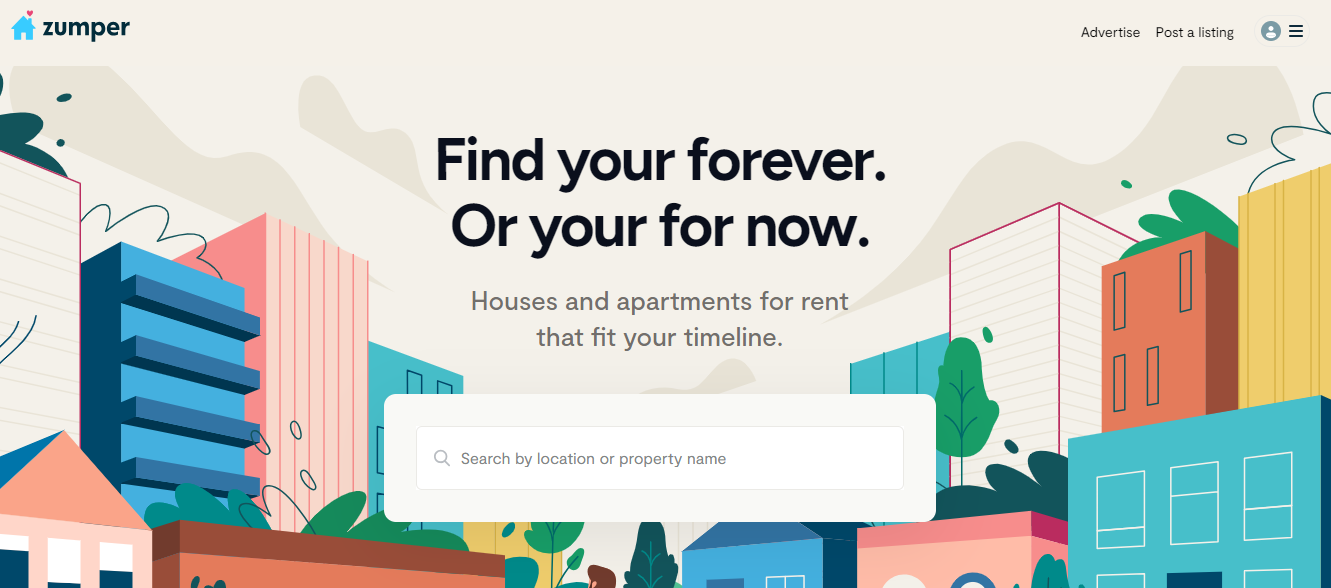
Zumper is a rental e-commerce brand that uses graphics and a user-focused slogan. There’s zero fluff and its search field CTA text is concise and drives action.
7 Considerations When Using a Website Builder for Your Small Business Lead Generation Website
1. Budget
Picking a website builder boils down to the built-in templates and apps you need. Some platforms are cheaper but offer fewer features. Others are pricier but offer more.
2. Design Customization
Choose a platform that offers many customizable design templates. Some platforms, like Snapps.ai, even offer customized coding and plugins that are easy to learn and use.
3. SEO-Friendly
Pick a platform with integrated SEO tools that will help optimize your small business search ranking and lead generation.
4. Mobile Responsiveness
Consider a website building platform with design templates optimized for mobile responsiveness.
5. Ease of Use
Choose a website builder that is easy to learn and use, and provides building guides.
6. Support
Get a website builder with good customer support so you have access to help.
7. Time
Get a website builder that shortens the time needed to create your lead gen website—including the time it takes for you to learn how it works.
The Benefits of Having a Small Business Lead Generation Website
- More notice of your brand beyond traditional advertising and word-of-mouth.
- Access to more prospective customers, local and global.
- Development of your online presence and social media.
- The ability to make your brand searchable via Google and social media.
- Improved conversion of leads into customers
- Better ROI than traditional advertisement methods
Over 25% of people in the US shop online, according to Forbes.com. They search for products and services and discover small businesses close to them. Of that number, 75% visit the website first before going to the brick-and-mortar store. This proves how advantageous having an online presence is for your small business.
Is the Effort to Learn How to Build a Lead Generation Website for Small Businesses Worth It?
Yes, the effort to learn how to build a lead generation website for small businesses is worth it. The benefits of using a website-building platform outweigh the cost, time, and effort.
However, many small business owners downplay the need for an online presence. According to Forbes.com, one in three small businesses in the US (29%) does not own a website. One reason cited is that owners think their businesses are too small to need a website. They think that the cost of building a website is not worth it. The lack of time, knowledge, and website-building skills are three other reasons that Forbes.com notes.
Using a website builder counters these excuses. It offers small business owners like you the opportunity to expand your business beyond its brick-and-mortar location. It is an affordable and effective solution to building your lead generation website. And the sooner you get your lead generation website running, the sooner you can drive sales and growth for your small business.
Recent Articles



Ready? Try it for Free
Sign up now and build your pages the way you envisioned. No credit cards required.
Our Support Heroes Are Here For You
Don’t waste time on tedious manual tasks. Let Automation do it for you. Simplify workflows, reduce errors, and save time for solving more important problems.
